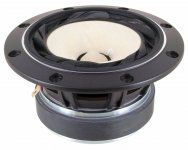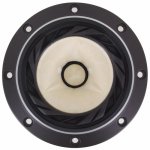Just saw mention of this venture in VoiceCoil magazine.
Lots of impressive resumes involved in this collaboration. Main focus is improved transducer design and class D amps from the looks of it.
Transducers - Purifi
Impressive performance for a 6.5" driver.
Lots of impressive resumes involved in this collaboration. Main focus is improved transducer design and class D amps from the looks of it.
Transducers - Purifi
Impressive performance for a 6.5" driver.
The next AudioXpress will have a report from me about a presentation Bruno and Lars did for the NL AES section. That will have more technical details about the improvements in both the class D and the driver.
Jan
Jan
There are some tests on the amplifier here Articles, Reviews and Measurements of Audio Products (As an Amazon Associate I earn from qualifying purchases) | Audio Science Review (ASR) Forum
Keith
Keith
that is way better than the best that are available right now....
very impressive THDs and response, I hope it sounds as good as the graph promise.
very impressive THDs and response, I hope it sounds as good as the graph promise.
Some of this appears to be overcoming the downside to small area long stroke drivers to make them comparable with the converse. Bandwidth is gained. Efficiency and voice coil diameter are not large.Main focus is improved transducer design
Why is long stroke good......large cone displacement causes doppler distortions does it not ?.
Dan.
Dan.
I'm glad to see them taking on speakers now. Electronics have been more than good enough for years at this point.
I like the systematic approach to design that they're doing. Focusing on problems that are the most audible in your typical 2-way bookshelf speaker system. I like my big speakers but I can appreciate the effort to get more out of a small box.
A controlled directivity design like the Kii or Dutch&Dutch using these improvements will make for even more impressive clean spl for a given size. Very attractive for the typical listening room.
I like the systematic approach to design that they're doing. Focusing on problems that are the most audible in your typical 2-way bookshelf speaker system. I like my big speakers but I can appreciate the effort to get more out of a small box.
A controlled directivity design like the Kii or Dutch&Dutch using these improvements will make for even more impressive clean spl for a given size. Very attractive for the typical listening room.
One would think. It's a type of FM or even IM distortion. There isn't much info about how it's tackled. The Jordan Eikonas are long throw and use "contraflex" cones, little info about that also and only in older papers.Why is long stroke good......large cone displacement causes doppler distortions does it not ?.
Some of this appears to be overcoming the downside to small area long stroke drivers to make them comparable with the converse. Bandwidth is gained. Efficiency and voice coil diameter are not large.
That is the case, yes. Risbo's investigations into making a small, long stroke as clean as a large short stroke lead him to some magnetic issues. And Bruno's investigations into possible 'granularity' in class D lead him to - magnetic issues (output filter coil). So that's the reason an amp designer and a speaker designer teamed up on the same issues ;-)
Edit: the reason for interest in small long stroke is of course because of the trend towards more compact speakers with adequate output levels.
Jan
Last edited:
Yup, just like I have stated in the past that typical class D amplifier ferrite output inductors are noisy, I also stated that ferrite speaker magnets are noisy and I also stated that I have solution for this, ie Goop changes noise properties of such ferrites.And Bruno's investigations into possible 'granularity' in class D lead him to - magnetic issues (output filter coil).
Dan.
Why is long stroke good......large cone displacement causes doppler distortions does it not ?.
Dan.
Yes but smaller woofer sell! I prefer woofers with low crossover frequency
Two details from their website Transducers - Purifi I find interesting:
The surround has segments protruding forwards and some backwards. I wonder how that reduces distortions.
Low magnetic hysteresis does that mean an ironless motor assembly?
Last edited:
What if the Doppler distortion is cancelled by the fact that the microphone is "dopplered" at the input of the process? Is there an argument that the long stroke exaggerates the relationship of the lows to the mids and highs on the diaphragm of the recording element?
huh???
this driver is too good to be true, it breaks the best midrange record by far, it exceeds by at least 10 to 20db the resolution of the best driver out there, no cost barrier, down to the 100hz... this is amazing... this driver should be in all audiophile systems.
I want one!
the sensitivity is not good, teh Qms is very high, dynamic speakers... moving mass on the high side, high BL, quite a big magnet.
this driver is too good to be true, it breaks the best midrange record by far, it exceeds by at least 10 to 20db the resolution of the best driver out there, no cost barrier, down to the 100hz... this is amazing... this driver should be in all audiophile systems.
I want one!
the sensitivity is not good, teh Qms is very high, dynamic speakers... moving mass on the high side, high BL, quite a big magnet.
What if the Doppler distortion is cancelled by the fact that the microphone is "dopplered" at the input of the process? Is there an argument that the long stroke exaggerates the relationship of the lows to the mids and highs on the diaphragm of the recording element?
Microphones have much less travel than a woofer so their doppler effect is minuscule compared to loudspeakers but yes theoretically it exists
The doppler effect can be compensated up to some degree in active systems with a phase modulator between crossover and amp. There are lots of people who like small and clever systems and this market segment is probably the main target of this driver.
Personally I find such things interesting from a technical point of view. But I prefer speakers of the old-fashioned large format studio monitor type. There are things that small speakers do better and there are things that large speakers do better. If someone is in a situation where he can't make use of the dynamics and SPL capabilities of large speakers he might definitely be better off with a small and clever active speaker system.
Regards
Charles
Personally I find such things interesting from a technical point of view. But I prefer speakers of the old-fashioned large format studio monitor type. There are things that small speakers do better and there are things that large speakers do better. If someone is in a situation where he can't make use of the dynamics and SPL capabilities of large speakers he might definitely be better off with a small and clever active speaker system.
Regards
Charles
Two details from their website Transducers - Purifi I find interesting:
The surround has segments protruding forwards and some backwards. I wonder how that reduces distortions.
A normal surround changes its effective area when moving from the front to the rear and back. That means that the effective cone area changes as a function of excursion which of course means distortion.
The funny surround shape is designed to minimize this.
Jan
Surround is in itself is very nonlinear so i'd be tempted to make it with reversed radius and hide it under some ring - to let only the rigid part of the cone emit sound.
- Home
- Loudspeakers
- Multi-Way
- Purifi Audio by Bruno Putzeys and friends.

